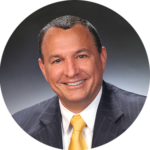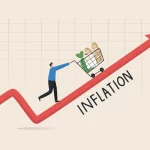A little more than two years ago I wrote a post entitled “Frothy Markets”, referring to the S&P 500’s incredible performance from late March 2020 to when it was written in May 2021 (you can click HERE to read it). The reason I’m bringing this up is because I see today’s S&P 500 back on the ascension, attempting to retake its previous all-time high of 4,796 (which eventually occurred in December 2021). That target is approximately 10% higher than where it currently stands as of this writing, well within striking distance.
Back when I wrote “Frothy Markets”, there were (in my opinion) three reasons why the S&P 500 continued its meteoric climb. A quote from the 2021 letter (italics):
first, many moderate to higher earners may have used their stimulus payments to invest in the equity markets. If someone didn’t actually need the payment(s), putting it to work is an efficient way to maximize growth from it. Secondly, since interest bearing accounts pay practically nothing (with the Federal Reserve holding rates at historic lows), what better vehicle to utilize than the stock markets where there’s a chance to get a better return than approximately 1%? Thirdly, no fear of the Fed. Jerome Powell has stated that, for the near term, the Fed has no plans to raise interest rates until inflation averages over 2%. This means that not only does inflation have to reach 2%, but in order to hit that average, it has to surpass it. This gives investors, both individuals and entities, virtually no incentive to invest in fixed income, which are bonds or cash equivalent accounts.
My, what a difference two years make. Let’s compare each reason to today:
first, many moderate to higher earners may have used their stimulus payments to invest in the equity markets. If someone didn’t actually need the payment(s), putting it to work is an efficient way to maximize growth from it.
It’s pretty clear there are no stimulus payments anymore to juice up spending. Increased spending translates into more sales and more profits, which lead to higher share prices. However, because of all that stimulus money that had entered into the economy, inflation started gaining traction, thereby making pretty much everything more expensive.
Secondly, since interest bearing accounts pay practically nothing (with the Federal Reserve holding rates at historic lows), what better vehicle to utilize than the stock markets where there’s a chance to get a better return than approximately 1%?
This one’s pretty much a no-brainer. If cash is generating less than 1%, why not put that cash to work in stocks that at least pay a dividend? Riding the upside climb to higher share prices is a bonus. After all, the more investors climb on board, the higher the climb goes. Today however, with rates significantly higher, the average investor has more choices in which to put their money. Yet, the consistent “stairstep” climb continues.
Thirdly, no fear of the Fed. Jerome Powell has stated that, for the near term, the Fed has no plans to raise interest rates until inflation averages over 2%. This means that not only does inflation have to reach 2%, but in order to hit that average, it has to surpass it. This gives investors, both individuals and entities, virtually no incentive to invest in fixed income, which are bonds or cash equivalent accounts.
Yet another no-brainer. With inflation at sub 2% and the Fed on vacation (they were begging for inflation), the green light had been given to keep the train rolling. And roll it did. Fixed income and cash equivalents paid paltry yields and it wouldn’t be until Jerome Powell started raising the Fed Funds rate that any interest in fixed income would transpire. Today, it’s the fear of the Fed continuing to raise rates and perhaps push the economy into recession.
So, to reuse the same statement from “Frothy Markets” in 2021, what’s the harm in an ever rising stock market (for 2023)? To answer that, let’s revisit what I said back then:
One is looming tax increases on the horizon.
President Biden has made no secret of the fact that he wants to raise taxes on the wealthy and corporations. Increasing the top rate to 39.6% for the wealthy, as well as increasing the corporate rate to 28% could have the “cold water on the economy” effect. After all, corporations tend to pass along increased costs to consumers. Lower sales mean lower profits, which translate into lower share prices.
Two: Increased price(s) (inflation), makes the cost of living more expensive and also garners the attention of the Fed. If inflation rises and unemployment remains low (healthy economy where demand is strong) the Fed will start becoming concerned about inflation and could raise interest rates. Rate increases in such a scenario may not have too much effect initially, however, if rates are continually raised, it will have the effect of throwing cold water on the recovery, thereby possibly lowering revenues.
We’re actually living and breathing in the above scenario today. Once the economy began to run hot (all one has to do is go to the grocery store for proof), Jerome Powell wasted no time in deciding to squash inflation by raising interest rates (no less than ten times!). As we’re all keenly aware, these hikes have had the desired effect of slowing spending by making financing large purchases much more expensive (think homes and vehicles), as well as buying on time for smaller purchases (credit cards). Consequently, it appears that because the cost of living has increased so dramatically, consumers are using their credit cards much more often. Per the Federal Reserve Bank of New York, the American consumer’s cumulative credit card balance is just shy of $1 Trillion, or $986 billion, the highest since the NY Fed began tracking in 1999. Add to that the sudden rise in vehicle repossessions and mortgage foreclosures (per NBCNews.com/business) and a slowing economy certainly appears to be in the cards. Add to all this that layoffs have started in the corporate sector and the table appears to have been set for an economic slowdown at the very least, if not an outright recession.
So….what to do?
Although the equity markets may still seem poised to increase for the very near future, they can turn on a dime at any time. And with the economy slowing due to higher rates, if you’re feeling uncertain and you’d like to discuss how to lock in some gains while still participating in potential upside of the S&P 500 (with no volatility), or if you’re getting ready to retire and are wondering where the guaranteed income is coming from, or if you simply want to continue to accumulate for retirement without the risk of the equity markets (with guarantees), please give me a call to discuss how to do so. I can always be reached at 941-704-3134 or via email at d.babecki@db3insuranceservices.com.
As always, thank you for reading and let me know if I can be of service.
About David J Babecki
David Babecki is the Owner/Founder of DB3 Insurance Services and has over 20 years of experience in personal insurance, proudly protecting clients against outliving their money, stock market risk, and of course, insuring their lives against the unforeseen.
David started his career with Raymond James & Associates in 2000 before becoming an independent agent where he offers a number of services to solve client needs. David has spent the majority of his life in the beautiful Tampa Bay area where he currently resides with his family.
David is a Licensed Life Insurance Agent FL # D053146
The above article reflects the opinions and thoughts of David J. Babecki. The information contained in this material is believed to be reliable, but not guaranteed. It is for informational purposes only and is not a solicitation to buy or sell any products which may be mentioned. It is not intended to be used as the sole basis for financial decisions, nor should it be construed as advice designed to meet the particular needs of an individual’s situation.
Please note: All guarantees and/or promises are based on the claims-paying ability of the respective insurance company.




